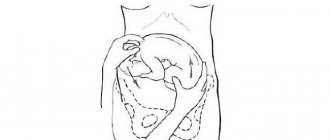Risk group
There can be many reasons for premature birth:
- If you have previously had abortions, miscarriages or premature births, if there are any anatomical defects in the structure of the uterus and its cervix, now you need to treat yourself especially carefully. In gynecology there is the concept of isthmic-cervical insufficiency, ICI (isthmus - “isthmus”, the place of transition of the uterine body into the cervix, cervix - “uterus”). During a normal pregnancy, this isthmus plays the role of a sphincter, a lock that locks the uterus. But if the isthmus is injured (during an abortion, especially during the first pregnancy, deep ruptures during previous births, gross dilatation of the cervical canal, etc.), the entrance to the uterus becomes under threat.
- Inflammatory and infectious diseases of the genital organs represent a serious problem. Therefore, if possible, it would be good to treat diseases such as colpitis, vaginosis, and be tested for infections such as chlamydia, trichomonas, and mycoplasma before pregnancy.
- Sometimes premature birth is caused by somatic diseases, especially kidney infections (pyelonephritis) and urinary tract, high blood pressure, heart disease, thyroid disease, hormonal disorders, etc.
- If the pregnancy is multiple, then premature birth can cause overstretching of the uterus.
- Sometimes even a seemingly harmless ARVI can cause premature birth, so try not to be in large crowds of people; you don’t need an extra infection right now.
- Another factor is nervous stress and hard work (both physical and intellectual). And therefore, for you now only you and your future baby should exist.
Prevention measures
To reduce the risk of miscarriage, when planning to conceive, all women need to undergo a comprehensive examination of the body in order to eliminate the provoking factors of such a pathology.
Early registration with the antenatal clinic and the introduction of pregnancy by an obstetrician-gynecologist reduces the likelihood of early delivery.
Women at risk especially need control from doctors: patients after artificial insemination, with sexual infantilism, endocrine diseases, chronic infections, menstrual disorders, negative Rh factor, recurrent miscarriage.
Warning signs
In obstetrics, preterm birth is defined as birth between 28 and 37 weeks. If at this time you feel some unusual symptoms, this is an urgent reason to at least call the doctor, and even better, to meet with him. So, if you have:
- Nagging pain in the lower abdomen, similar to menstrual pain.
- Heaviness in the lower abdomen, it seems to you that something is pressing hard on the bladder and vagina.
- Bloody discharge from the genital tract.
- Cramping pain that lasts more than 30 seconds. Just don’t confuse them with training contractions (how to distinguish training contractions from real ones - see the article “Labor Begins”).
- Leakage of clear fluid from the vagina.
- You have stopped feeling fetal movements.
The doctor will assess your condition and may suggest hospitalization in a maternity hospital. But don’t panic ahead of time - in many cases, labor can be slowed down with the help of special medications, psychotherapy, an electric uterine relaxer, acupuncture, etc.
What happens to the baby after premature birth?4
Currently, it is possible to nurse children whose body weight at birth is more than 1 kilogram, but, unfortunately, such low birth weight babies survive only in 50% of cases. Sometimes children with a body weight of 500 to 1000 grams are nursed, but this happens extremely rarely, in addition, it is a very, very expensive process. Children born weighing more than 1500 grams are easier for pediatricians to care for, since all their organs are more “mature.”
At the second stage of nursing, premature babies are often sent to children's hospitals.
1
Preterm birth is usually diagnosed after 28 weeks of pregnancy.
Spontaneous termination of pregnancy between conception and 28 weeks is called spontaneous abortion (miscarriage). For more information about the threat of termination of pregnancy, see: A. Koroleva, “Threat of termination of pregnancy” / No. 1 -2001. 2
For more information about infectious diseases, see: Zh. Mirzoyan “You need to know the enemy by sight.
TORCH infections - what is it?”/No. 4-2001; S. Gonchar “Treatment is light, and non-treatment is darkness. Diseases that threaten intrauterine infected fetuses”/No. 5-2001. 30
during the postpartum period, see N. Brovkina’s article “The Fourth Trimester” in this issue of the magazine.
4
The subject of this article is premature birth, so literally a few lines are devoted to nursing premature babies. Detailed material on methods of caring for premature and low birth weight babies will be published in one of the upcoming issues of our magazine.
Give birth or wait?
What awaits you in the maternity hospital? If the amniotic sac is not broken, you will:
- Ultrasound examination (it will show the condition of the fetus and the tone of the uterus)
- Vaginal examination for dilatation of the uterus - you need to find out how smooth and shortened it is, whether the uterine os is open
- Blood test for testosterone.
- Blood test for intrauterine infection (rubella, toxoplasmosis, herpes, cytomegaly).
- Blood test and smear for chlamydia, mycoplasma, ureaplasma.
Depending on the results obtained, the doctor chooses a method to suspend labor. For this purpose, medications are used - tocolytics, tablets and suppositories with indomethacin, etc. It is quite possible that you will soon be allowed to go home in peace - to carry your treasure to term and take sedatives, antispasmodics, and, if necessary, hormones. You will need to abstain from sexual relations for now.
If you experience isthmic-cervical insufficiency before 28 weeks, special “tightening” sutures are sometimes placed on the cervix. At a period later than 28 weeks, instead of sutures, a special support ring can be inserted, which, without narrowing the cervix, will hold the fetus inside the mother's womb.
Another option for maintaining pregnancy is to lie in the maternity hospital for some time. It is possible that the doctor will need to monitor your baby’s condition all the time, and this requires hospital conditions. Bed rest is strictly required during this time! For up to 34 weeks, the mother must be prescribed hormonal medications, which, just in case, should speed up the maturation of the baby’s lungs.
Finally, the third option is childbirth. In severe forms of late toxicosis or a threat to the life of the mother or baby, premature birth sometimes becomes the only way out (for example, if placental abruption unexpectedly occurs or acute fetal hypoxia occurs). According to statistics, premature births range from 4 to 16%. In Moscow, there are two maternity hospitals that specialize specifically in premature births - maternity hospital No. 15 (Sharikopodshipnikovskaya St., 3) and No. 8 (Vyatsky per., 29).
Premature birth
They have their own characteristics. As a rule, they begin with premature rupture of amniotic fluid. Approximately 35% of such births proceed quickly - for primiparas the entire process takes less than six hours, for multiparas - less than four. In this case, labor activity may be weak or discoordinated (after all, the cervix is not yet fully ripe for childbirth, and the mechanisms of labor forces do not work very harmoniously). The cervix may open unevenly, with the intervals between contractions rapidly increasing and the contractions themselves lasting longer. Doctors try to accept the baby, who is in such a hurry to be born, as carefully as possible, because the risk of birth trauma is especially high for him.
They also take a careful approach to pain relief during labor. Narcotic painkillers are not used under any circumstances - this can have a detrimental effect on the development of the child’s respiratory system. Epidural or spinal anesthesia is usually used. To minimize birth trauma, a preventive dissection of the perineum is also performed - episiotomy or perineotomy.
Often, even before the onset of premature birth, placental abruption may occur or infectious complications may occur (for example, inflammation of the membranes - chorioamnionitis). In the postpartum period, bleeding is possible, especially if during childbirth there are difficulties with the separation of the placenta. But in general, the postpartum period does not differ from normal births that occur on time. Therefore, if a new mother is detained in the maternity hospital, then most often this happens not because of her, but because of the child.
Complications
Due to the immaturity of all internal organs, premature babies may experience:
- birth injuries (damage to the cervical segment of the spine, hemorrhages into the cranial cavity);
- hypoxia;
- functional immaturity of the lungs.
For a woman in labor, such an end to pregnancy can lead to rupture and injury to the reproductive organs, postpartum blood loss and infections (suppuration of sutures, inflammation of the peritoneum, internal mucous and muscular layer of the uterus, blood poisoning).
Tiny little rushers
But then your baby was born (link to the article “Premature baby - care and features”). And from now on you have a special responsibility - after all, he will have to adapt to this world a little earlier than the due date. Don't worry ahead of time, the adaptive capabilities of premature babies are very great. In the intensive care unit, the babies’ condition is monitored around the clock.
Recently, a new direction has appeared in pediatrics - follow-up, created specifically for premature babies. This is a comprehensive observation and treatment by a neurologist, ophthalmologist, pediatrician and other specialists. When the baby learns to suck on his own, begins to gain weight, and can stay outside the incubator, he can be discharged home with his mother.
If your family has a child born prematurely, here are some useful addresses:
- Scientific Center for Children's Health of the Russian Academy of Medical Sciences (second and third stages of nursing and rehabilitation of premature babies). Lomonosovsky pr-t, 2/62, t. 132 7492.
- Family Planning and Reproduction Center (follow-up department). Sevastopolsky Ave., 24, t. 332 2915
- Institute of Nutrition (testing for food allergens, nutrition selection, gastroenterological problems, diathesis, dysbacteriosis). Kashirskoye sh., 5, t. 113 1995
- Center for Corrective Pedagogy (neurological problems, speech delay). Pogodinskaya st., 8, building 1, t.2452530
- Nephro-urological center at Children's Clinical Hospital No. 13 named after. N.F. Filatova, (kidney problems, nephritis, pyelonephritis, PMR, malformations of the urinary tract, hydronephrosis). St. Sadovaya-Kudrinskaya, 15, t. 254 9129
- Consultative Department of Vascular Surgery, t. 254–05–38.
- Children's City Orthopedic Center at Children's City Hospital No. 19 named after. T.S. Zatsepin (problems related to the musculoskeletal system, hip dysplasia). St. B. Cherkizovskaya, possession 12, t.: 168 8646.587 3465.
- Clinic of Eye Diseases named after. Helmholtz. St. Sadovaya-Chernogryazskaya, 14/9, t. 208 0026
- Children's Clinical Hospital No. 1 Morozovskaya: Department of Children's Diseases No. 1, Hematology Center, Department and Department of ENT Diseases, Department of Ophthalmology (specialist consultations, treatment). 4th Dobryninsky lane, 1, t. 959 8904.
Inessa Smyk
Sources
- Sun WY., Li CG., Zhang H., Ren W., Cui LL., Yuan X. [The correlation between serum uric acid levels in the third trimester of pregnancy and adverse pregnancy outcomes]. // Zhonghua Nei Ke Za Zhi - 2021 - Vol60 - N5 - p.446-452; PMID:33906274
- Park S., Oh D., Heo H., Lee G., Kim S.M., Ansari A., You YA., Jung YJ., Kim YH., Lee M., Kim YJ. Prediction of preterm birth based on machine learning using bacterial risk score in cervicovaginal fluid. // Am J Reprod Immunol - 2021 - Vol - NNULL - p.e13435; PMID:33905152
- Moufarrej MN., Wong RJ., Shaw GM., Stevenson DK., Quake SR. Corrigendum: Investigating Pregnancy and Its Complications Using Circulating Cell-Free RNA in Women's Blood During Gestation. // Front Pediatr - 2021 - Vol9 - NNULL - p.680201; PMID:33903851
- Moreno-Sepulveda J., Espinós JJ., Checa MA. Lower risk of adverse perinatal outcomes in natural versus artificial frozen-thawed embryo transfer cycles: a systematic review and meta-analysis. // Reprod Biomed Online - 2021 - Vol - NNULL - p.; PMID:33903031
- Zheng L., Gai L., Gao J., Kong C., Wang Y., Sun F., Liu S., Yu X., Yang F., Jiang H. Clinical effects of breast milk enema on meconium evacuation in premature infants: study protocol for a randomized controlled trial. // Trials - 2021 - Vol22 - N1 - p.304; PMID:33902678
- Fondjo LA., Tashie W., Owiredu WKBA., Adu-Gyamfi EA., Seidu L. High prevalence of vitamin D deficiency among normotensive and hypertensive pregnant women in Ghana. // BMC Pregnancy Childbirth - 2021 - Vol21 - N1 - p.331; PMID:33902494
- Carrasco I., Muñoz-Chapuli M., Vigil-Vázquez S., Aguilera-Alonso D., Hernández C., Sánchez-Sánchez C., Oliver C., Riaza M., Pareja M., Sanz O., Pérez- Seoane B., López J., Márquez E., Domínguez-Rodríguez S., Hernanz-Lobo A., De León-Luis JA., Sánchez-Luna M., Navarro ML. SARS-COV-2 infection in pregnant women and newborns in a Spanish cohort (GESNEO-COVID) during the first wave. // BMC Pregnancy Childbirth - 2021 - Vol21 - N1 - p.326; PMID:33902483
- Perrone S., Cremonini I., Marinelli F., Monaco S., Nicoletti L., Giordano M., Esposito S. New Strategies for Necrotizing Enterocolitis Diagnosis and Prevention in Newborns. // Curr Pediatr Rev - 2021 - Vol - NNULL - p.; PMID:33902422
- Sharpe A., Mascarenhas M., Balen A. Ethnic variation in the live birth rate and perinatal outcomes following frozen embryo transfer: an analysis of the HFEA database from 2000 to 2021. // Hum Fertil (Camb) - 2021 - Vol - NNULL - p.1-10; PMID:33902383
- Yang YJ., Wei X., Zou G., Zhou FH., Sun LM. . // Zhonghua Fu Chan Ke Za Zhi - 2021 - Vol56 - N4 - p.244-250; PMID:33902235








